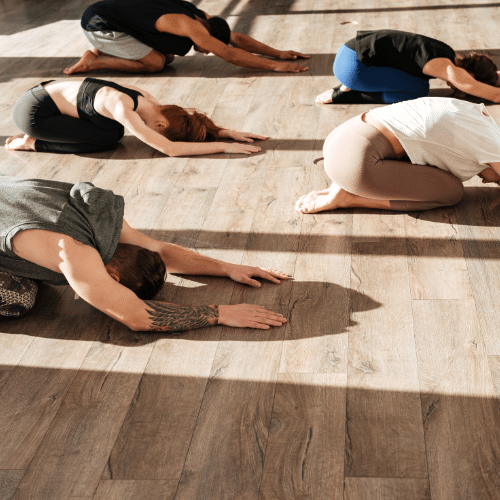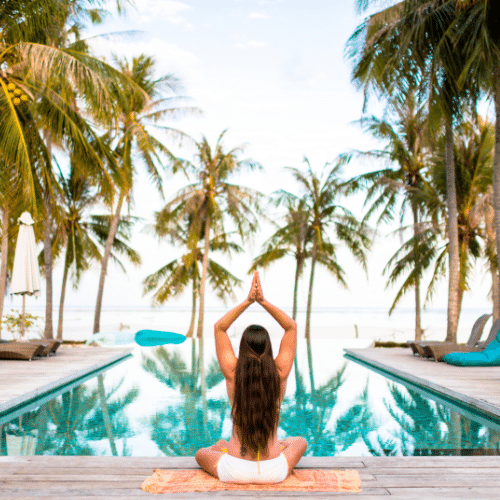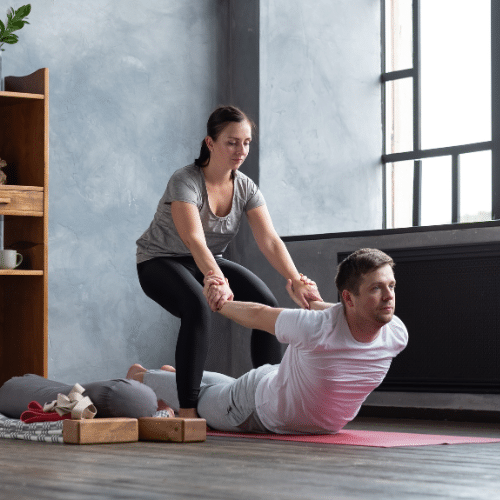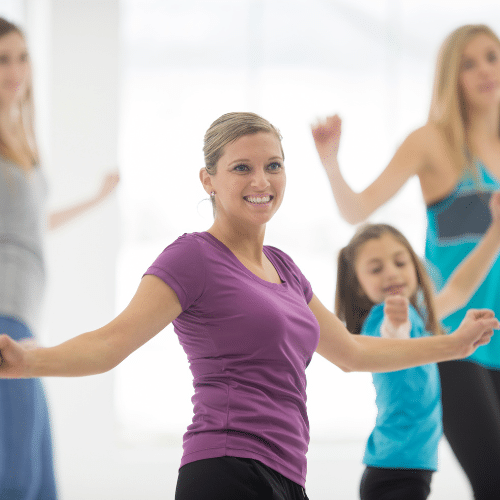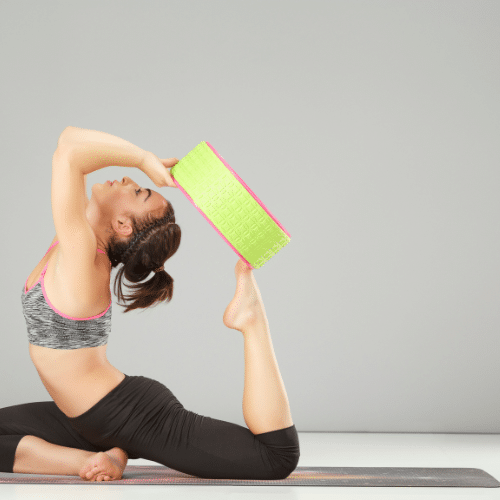Introduction
Yin Yoga is a slow-paced style of yoga that focuses on deep tissue stretching, mindfulness, and meditative aspects. Unlike the more active styles of yoga, Yin Yoga involves holding poses for longer periods, typically 3 to 5 minutes, allowing for a deep release in the connective tissues of the body. The practice also encourages a meditative and mindful approach, aiming to cultivate inner stillness and awareness.
Originating in the late 1970s, Yin Yoga has its roots in traditional Chinese medicine and Taoist principles. The practice was developed by Paulie Zink, a martial arts champion and Taoist yoga teacher, who was inspired by the Yin and Yang philosophy, where Yin represents stillness and cooling, while Yang represents movement and heat. In traditional Chinese medicine, Yin is associated with the deep, dense, and less pliable tissues of the body, such as the ligaments, tendons, and fascia. Therefore, Yin Yoga aims to target these tissues to improve flexibility and joint mobility.
Overall, Yin Yoga offers a gentle yet profound way to connect with the body and mind, promoting relaxation, balance, and inner peace.
Understanding Yin Yoga
Yin yoga is a gentle and meditative practice that aims to target the deep connective tissues of the body. Unlike more dynamic styles of yoga, yin yoga involves holding passive poses for extended periods of time, typically around three to five minutes. This allows for a deep release of tension and a gentle opening of the body.
The practice of yin yoga is based on the concept of yin and yang, an ancient Chinese philosophy that represents the complementary forces of nature. In this philosophy, yin is the stable, unmoving, and hidden aspect, while yang is the active, moving, and outward aspect. In yin yoga, we are focusing on the yin aspects of our bodies – the deeper connective tissues, tendons, ligaments, and fascia.
Yin yoga poses are often held close to the ground, and the use of props such as bolsters, blankets, and blocks can help support the body and encourage relaxation. The practice is designed to be slow and meditative, allowing practitioners to deeply connect with their breath and explore sensations in the body.
One of the key principles of yin yoga is finding your edge – the point at which you feel a gentle stretch or sensation, but not to the point of discomfort or pain. By finding this edge and allowing the body to relax into the pose, we can begin to release tension and create more space in the body.
Yin yoga is also a great practice for cultivating mindfulness and introspection. The long holds in each pose provide an opportunity to observe the thoughts and sensations that arise, and to practice acceptance and non-judgment. This can be particularly beneficial for those dealing with stress, anxiety, or chronic pain.
Overall, yin yoga is a deeply nurturing and introspective practice that can help to balance our often fast-paced and yang-dominated lives. By taking the time to slow down and connect with the yin aspects of our bodies, we can cultivate a greater sense of ease, relaxation, and well-being.
The Principles of Yin Yoga
Yin Yoga is based on the principles of stillness, depth, and time. The practice focuses on holding poses for longer durations, typically three to five minutes or even longer. This prolonged hold allows for a deeper stretch and targets the connective tissues, such as ligaments, tendons, and fascia. These tissues require longer stretches to properly release and lengthen, compared to the muscles which are more suited to dynamic, shorter stretches.
Stillness is a key principle in Yin Yoga, encouraging practitioners to find a comfortable position and then remain still, both physically and mentally. This stillness allows for a deeper introspective experience and helps to cultivate a sense of mindfulness.
Depth refers to the intensity of the stretch, with practitioners encouraged to relax into the pose and allow gravity to gently deepen the stretch. This helps to create more space within the body and release tension from the connective tissues.
The concept of time in Yin Yoga refers to the duration of the poses, with longer holds allowing for a gradual release and opening of the targeted areas. This prolonged stretching can improve flexibility, increase circulation, and reduce the risk of injury.
Overall, the core principles of Yin Yoga emphasize the importance of holding poses for longer durations to stretch connective tissues, cultivate stillness, and promote a deep, introspective practice.
Key Components of Yin Yoga
Yin yoga is a form of yoga that focuses on long-held, passive poses that target the connective tissues in the body. It is a slow, meditative practice that helps to increase flexibility, release tension, and improve overall well-being. There are several key components of yin yoga that make it unique and beneficial for practitioners.
One of the key components of yin yoga is the emphasis on holding poses for an extended period of time. In a typical yin yoga class, poses are held for anywhere from 3 to 5 minutes, and sometimes even longer. This extended duration allows for a deep release in the connective tissues, helping to improve flexibility and mobility in the joints.
Another key component of yin yoga is the use of props. Props such as blocks, bolsters, and blankets are often used to support the body in yin poses, allowing for a deeper release and a more comfortable experience. Props help practitioners to find their edge in a pose without pushing beyond their limits, and can be especially beneficial for those with limited mobility or flexibility.
Breath awareness is also a key component of yin yoga. Practitioners are encouraged to focus on their breath throughout the practice, using it as a tool to deepen their experience in each pose. By maintaining a steady, even breath, practitioners can access a state of relaxation and calm that can be difficult to achieve in more dynamic forms of yoga.
Finally, yin yoga emphasizes the concept of surrender. Practitioners are encouraged to let go of any tension or resistance in the body, and to surrender to the experience of each pose. This focus on surrender can help to release stress and anxiety, and promote a sense of inner peace and relaxation.
Overall, the key components of yin yoga – long-held poses, the use of props, breath awareness, and surrender – combine to create a practice that is deeply restorative and beneficial for both the body and the mind. Whether you are looking to improve your flexibility, release tension, or simply find a moment of peace in your day, yin yoga offers a gentle and effective way to achieve your goals.
Poses
1. Child’s Pose (Balasana) – This pose involves sitting on your heels and reaching your hands forward while stretching your spine. It helps to release tension in the back, hips, and shoulders, as well as calming the mind and relieving stress.
2. Butterfly Pose (Baddha Konasana) – Sitting with the soles of your feet touching and knees wide, you lean forward to stretch the inner thighs and groin area. This pose targets the hips and lower back, helping to increase flexibility and release stagnant energy in the pelvic region.
3. Sphinx Pose (Salamba Bhujangasana) – Lying on your stomach with elbows underneath your shoulders, this pose gently opens the chest and lengthens the spine. It can help to alleviate lower back pain and improve posture.
4. Dragon Pose (Utthan Pristhasana) – This deep hip opener involves lunging forward with one leg and extending the back leg behind you. It stretches the hip flexors and groin while also stimulating the liver and gallbladder meridians.
5. Snail Pose (Salamba Sarvangasana) – This inverted pose involves rolling onto your back and lifting your legs over your head. It releases tension in the spine and neck while calming the nervous system.
These poses are held for several minutes in Yin Yoga to target deep connective tissues and improve flexibility, circulation, and energy flow in the body.
Breathing
Breathwork plays a significant role in Yin Yoga as it helps practitioners to deepen their relaxation and release tension in their bodies. In Yin Yoga, the focus is on holding passive poses for an extended period, typically between 3 to 5 minutes or even longer. Throughout these long holds, proper and conscious breathing is essential to help release any resistance or discomfort in the body.
The breathwork in Yin Yoga aims to facilitate the flow of energy or “chi” throughout the body. Deep, slow and steady breaths help to calm the mind and relax the nervous system, allowing practitioners to sink deeper into the poses and experience a profound stretch in their connective tissues.
Conscious breathing also helps to cultivate mindfulness and present moment awareness, which are foundational aspects of Yin Yoga. By paying attention to the breath, practitioners can develop a deeper connection with their bodies and emotions, enhancing their overall yoga experience.
In summary, breathwork in Yin Yoga is a crucial component that aids in relaxation, energy flow, and mindfulness. It enables practitioners to surrender into the poses, release tension, and tap into the deeper layers of their being.
Mindfulness
Mindfulness is a practice that focuses on being present in the moment, observing thoughts and emotions without judgment. This meditative aspect of mindfulness allows individuals to cultivate a sense of inner peace, awareness, and clarity. By consistently practicing mindfulness, individuals can train their minds to stay present and calm, even in the midst of stressful or chaotic situations.
One of the most significant benefits of the meditative aspect of mindfulness is the reduction of stress and anxiety. By learning to observe and acknowledge thoughts and feelings without getting swept away by them, individuals can develop a greater sense of control over their mental and emotional state. This can lead to improved overall well-being and mental health.
Additionally, the meditative aspect of mindfulness can also enhance self-awareness and self-compassion. By regularly practicing mindfulness meditation, individuals can develop a deeper understanding of themselves and their inner workings. This increased self-awareness can lead to better decision-making, more fulfilling relationships, and an overall greater sense of contentment with life.
In conclusion, the meditative aspect of mindfulness can offer numerous benefits, including stress reduction, improved mental health, and increased self-awareness. By incorporating mindfulness into daily life, individuals can cultivate a greater sense of inner peace and resilience.
The Physical and Mental Benefits of Yin Yoga
Yin yoga is a slow-paced style of yoga that focuses on holding poses for an extended period of time, typically ranging from 3 to 5 minutes. This practice targets the deep connective tissues of the body, such as the fascia, ligaments, and joints, and aims to improve flexibility and joint mobility. While yin yoga may appear to be a passive form of exercise, it offers a myriad of physical and mental benefits that contribute to overall well-being.
From a physical standpoint, yin yoga helps to release tension in the body and improve flexibility. By holding poses for an extended period, it allows for a deeper stretch that targets the connective tissues, ultimately increasing the range of motion in the joints. This can be particularly beneficial for individuals who may experience stiffness or tightness in certain areas of the body. Additionally, yin yoga can help to improve circulation and stimulate the flow of energy throughout the body, promoting overall vitality and wellness.
In addition to its physical benefits, yin yoga also provides numerous mental advantages. The slow and meditative nature of this practice encourages mindfulness and presence in the moment. By focusing on the breath and staying present in each pose, practitioners can cultivate a sense of calm and relaxation, alleviating stress and anxiety. Moreover, yin yoga can also serve as a form of mental and emotional release, as the long-held poses may bring up stored emotions and allow for their release.
Furthermore, the meditative nature of yin yoga can also promote a sense of inner peace and introspection, helping individuals to connect with their inner selves and gain clarity and perspective. This practice can be particularly beneficial for those who lead busy and hectic lifestyles, as it provides an opportunity to slow down, unwind, and recharge both the body and mind.
Ultimately, yin yoga offers a holistic approach to physical and mental well-being. By incorporating this practice into a regular exercise routine, individuals can experience improved flexibility, reduced stress, and a greater sense of overall balance and harmony. Whether you are a seasoned yogi or new to the practice, yin yoga can be a valuable addition to your wellness repertoire.
Improves Flexibility and Mobility
Yin Yoga targets connective tissues such as ligaments and fascia through long-held, passive poses. This practice focuses on stretching and stressing these tissues in a gentle, sustained manner to improve overall flexibility and joint mobility.
During a Yin Yoga session, poses are typically held for 3-5 minutes or even longer, allowing the muscles to relax and the focus to shift to the deeper connective tissues. This prolonged stretching stimulates the production of synovial fluid, which lubricates the joints and increases their range of motion. Additionally, the gentle stress applied to the ligaments and fascia encourages the development of collagen, making these tissues more flexible and resilient over time.
Furthermore, the slow and deliberate nature of Yin Yoga helps to release tension and tightness in the muscles, allowing for greater freedom of movement in the joints. By targeting the connective tissues, Yin Yoga not only improves flexibility and joint mobility but also supports joint health and prevents injuries. This makes it an effective practice for individuals looking to enhance their overall physical well-being.
Enhances Circulation
Yin yoga poses, with their gentle and slow-paced nature, can enhance blood circulation in the body, ultimately promoting better organ health and vitality. The prolonged holds and gentle stress placed on the body during Yin poses help to stimulate blood flow to different areas, allowing for improved circulation throughout the body.
The increase in blood circulation that results from the practice of Yin yoga can benefit organ health by providing essential nutrients and oxygen to the various organs, helping them function more efficiently. Improved blood flow can also aid in the removal of waste and toxins from the body, further supporting organ health and overall vitality.
Yin poses specifically target the deep connective tissues and fascia in the body, which can often become stiff and restricted. By gently stretching and stressing these tissues, blood circulation to these areas is enhanced, supporting their health and mobility.
Overall, the gentle stress and prolonged holds of Yin poses can help to improve blood circulation, leading to better organ health and increased vitality throughout the body. This makes Yin yoga a valuable practice for promoting overall well-being and health.
Reduces Stress and Anxiety
Yin Yoga is a slow-paced style of yoga that involves holding gentle poses for an extended period of time, typically three to five minutes. This meditative practice allows for deep relaxation and a focus on the breath, which can help calm the mind, reduce stress levels, and alleviate anxiety.
The long, passive holds in Yin Yoga can help release tension in the body, which in turn can help quiet the mind. By focusing on the breath and the present moment during these extended holds, practitioners can cultivate a sense of mindfulness and reduce the racing thoughts that often accompany stress and anxiety.
Yin Yoga also targets the connective tissues in the body, such as the fascia, ligaments, and joints, which can help improve flexibility and mobility. This physical release can contribute to a sense of ease in the body and mind, further reducing stress and anxiety.
Additionally, the meditative aspect of Yin Yoga encourages practitioners to embrace stillness and introspection, providing an opportunity to let go of worries and concerns. This mental clarity and sense of peace can be instrumental in reducing stress levels and alleviating anxiety.
Incorporating Yin Yoga into a regular wellness routine can offer profound benefits for both the mind and body, providing a soothing and restorative practice that promotes overall well-being.
Fosters Mindfulness and Greater Self-Awareness
The practice of mindfulness encourages individuals to be present in the moment, which allows them to deepen their connection to their body and mind. By focusing on the present moment, practitioners become more aware of their thoughts, feelings, and bodily sensations. This heightened awareness can lead to a deeper understanding of how their body and mind are interconnected.
Mindfulness practices, such as meditation or yoga, also encourage individuals to pay attention to their breath and bodily sensations. This increased awareness of the body can help practitioners recognize areas of tension or discomfort, and take steps to address these issues through relaxation techniques or seeking out physical therapy. Additionally, mindfulness can deepen the connection between the body and mind by allowing individuals to recognize how their emotions and thoughts can manifest as physical sensations in the body.
Overall, mindfulness fosters a greater sense of self-awareness by encouraging individuals to be present and attentive to their inner experiences. This can lead to a deeper understanding of one’s thoughts, emotions, and bodily sensations, ultimately promoting a more holistic connection between the body and mind.
Yin Yoga vs. Other Yoga Practices
Yin Yoga is a slow-paced practice that focuses on holding passive poses for an extended period, typically 3-5 minutes. Its main objective is to target the deep connective tissues of the body and improve flexibility and joint mobility. It also aims to promote relaxation and mindfulness, making it a more meditative and introspective practice. The physical aspect of Yin Yoga targets the hips, pelvis, and lower spine, while the mental aspect aims to calm the mind and release tension.
In contrast, dynamic practices like Vinyasa or Ashtanga are faster-paced and focus on flowing from one pose to the next, synchronizing movement with breath. They are more physically challenging, aiming to build strength, endurance, and cardiovascular fitness. These practices also target mental focus, but in a more active and energizing way, aiming to create a sense of flow and harmony between the body and mind.
While Yin Yoga and dynamic practices both offer physical and mental benefits, they cater to different needs and preferences. Yin Yoga is ideal for those looking to slow down, improve flexibility, and cultivate a sense of inner calm, while Vinyasa and Ashtanga are better suited for those seeking a more vigorous workout and a dynamic, energizing practice.
Preparing for a Yin Yoga Session
Practitioners can expect a slow-paced and introspective experience during a Yin Yoga class. The focus is on holding passive, seated and supine poses for a longer duration (usually 3-5 minutes), allowing for deep stretching and targeting the connective tissues.
To prepare for a Yin Yoga session, it’s important to create a calm and quiet environment. This can be achieved by dimming the lights, playing soft music, and using essential oils to set a relaxing ambiance. Practitioners should gather props such as yoga blocks, bolsters, blankets, and straps to support their body and enhance the stretching experience. Comfortable and loose-fitting clothing is recommended, as well as bringing a water bottle and a light snack if needed.
Additionally, it’s important to mentally prepare for the practice by setting an intention or focus for the session. This could be related to letting go of tension, finding stillness, or cultivating mindfulness.
Yin Yoga is suitable for all levels, but it’s important for practitioners to listen to their bodies and adjust the poses as needed to avoid discomfort or strain. The slow and meditative nature of Yin Yoga makes it a perfect complement to more active styles of yoga, and it can be a deeply relaxing and rejuvenating practice.
Conclusion
In conclusion, Yin Yoga offers a unique approach to yoga as it targets the deep connective tissues of the body and promotes relaxation and meditation. Its slow-paced and passive nature allows for a gentle yet profound release of tension and stress, offering both physical and mental benefits.
The long-held poses in Yin Yoga stimulate the meridian lines in the body, promoting better energy flow and mind-body balance. This practice also helps improve flexibility, joint mobility, and mental clarity. It provides a perfect counterbalance to more dynamic and active styles of yoga, making it an excellent complement to existing practices.
For those new to yoga, Yin Yoga offers a gentle introduction to the world of yoga, without requiring a high level of physical fitness or flexibility. It’s a wonderful way to ease into a more extensive yoga practice, as it encourages mindfulness and introspection.
Whether you’re looking to enhance your current yoga routine or simply looking for a gentle way to relax and de-stress, Yin Yoga is worth exploring. Its unique benefits make it a valuable addition to anyone’s wellness routine. So, if you haven’t already, consider giving Yin Yoga a try and experience the profound effects it can have on your body and mind.


